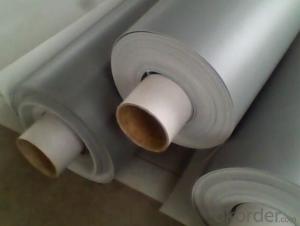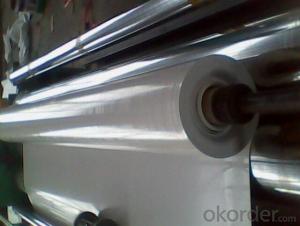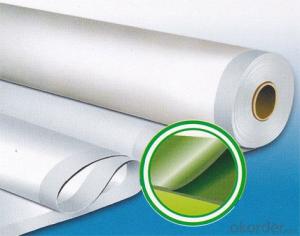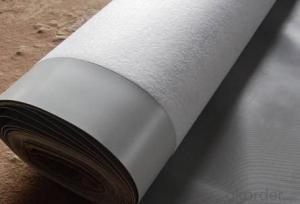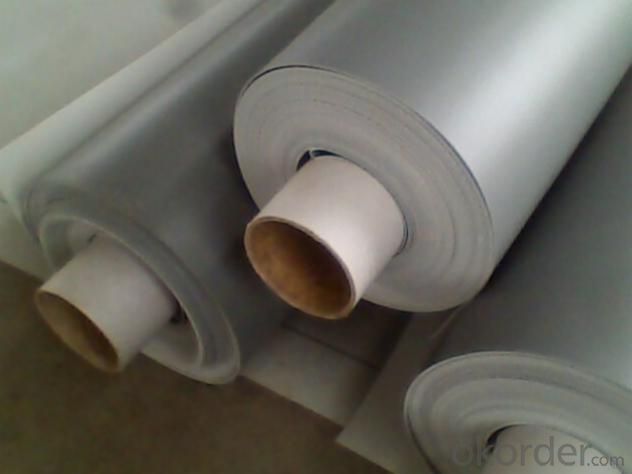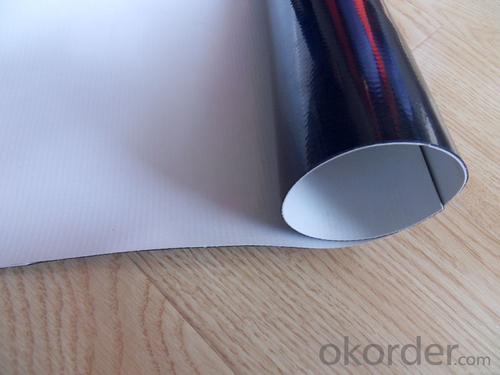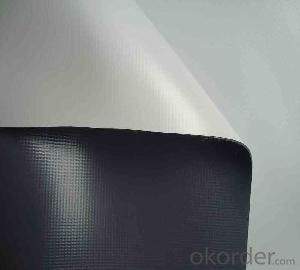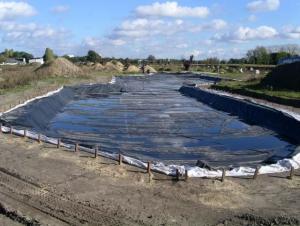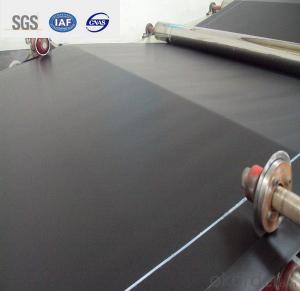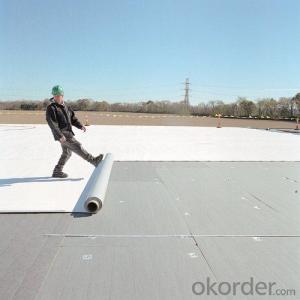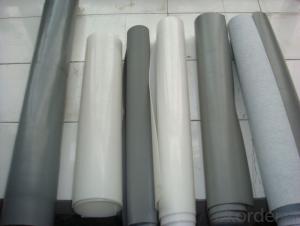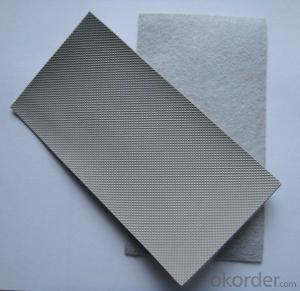PVC Waterproofing Membrane with UV-Resistance
- Loading Port:
- Shanghai
- Payment Terms:
- TT OR LC
- Min Order Qty:
- 20000 m²
- Supply Capability:
- 5000000 m²/month
OKorder Service Pledge
OKorder Financial Service
You Might Also Like
PVC Waterproofing Membrane with UV-Resistance
Product Description of PVC Waterproofing Membrane with UV-Resistance:
PVC waterproofing membrane is an excellent high-quality polymer waterproof sheet, made of PVC resin by adding plasticizer, anti-UV agent, anti aging agent, and stabilizer and other processing aids through extrusion and molding. As the highly recommended product by the Ministry of Construction, it is featured by high tensile strength, great elongation, good stability, small shrinkage, low-temperature performances, good resistance to weathering and root
penetration, and long service life.
Features of PVC Waterproofing Membrane with UV-Resistance:
1.Long service life and weathering resistance; and the materials can be used for 30 years on the roof and 50 years underground.
2. High tensile strength, great elongation, and small size change during heat treatment.
3. Good low temperature flexibility and adaptability to environmental temperature changes.
4. Good resistance to root penetration. It can be made for green roofs.
5. Excellent resistance to puncture and impact.
6. Convenient for construction (can be welded), solid and reliable, and Eco-friendly.
7. Strong resistance to chemical corrosion, suitable for special occasions.
8. Good plasticity, convenient and quick corner detail treatment. Easy maintenance and low cost.
9.After 2,000 hours of manual weathering verification
Classification of PVC Waterproofing Membrane with UV-Resistance:
1. N: Homogeneous PVC membrane
2. L: PVC membrane with fabric backing
3. W: Reinforced PVC membrane
Advantage of PVC Waterproofing Membrane with UV-Resistance:
1.) Mixing automation. Apply automatic temperature control automatic time control and automatic feed control.
2.) Extrusion equipment uses twin screw coextrusion. Screw temperature uses computer automatic temperature control system.
3.) Handpiece uses large width didhead extrusion equipment.
4.) Sophisticated three-roller calender equipment. The space between equiment is controlled by automation system.
Technical Data of PVC Waterproofing Membrane with UV-Resistance:
No. | Item | Model Ⅱ | |
1 | Tensile Strength Mpa ≥ | 12.0 | |
2 | Elongation at break% ≥ | 250 | |
3 | Shrinkage rate % ≤ | 2.0 | |
4 | Flexibility at low temperature | No crackle at -25oC | |
5 | Water tightness | Watertight | |
6 | Puncture resistance | Watertight | |
7 | Heat aging treatment | Appearance | Free from bubble, crack, cohesion and void |
Change rate of tensile strength % | +20oC | ||
Change rate of elongation at break | |||
Flexibility at low temperature | No crack at -20oC | ||
8 | Chemical corrosion resistance | Change rate of tensile strength % | +20 |
Change rate of elongation at break | |||
Flexibility at low temperature | No crack at -20oC | ||
9 | Artificial weathering | Change rate of tensile strength % | +20 |
Change rate of elongation at break | |||
Flexibility at low temperature | No crack at -20oC | ||
Application of PVC Waterproofing Membrane with UV-Resistance:
1) All kinds of roofs, such as steel structure roof, planted roof etc.
2) Underground engineering, such as building basement, subways, tunnels, air raid shelter, etc.
3) Other projects like artificial lake, dam, water reservoir, grain storehouse, etc.
Images of PVC Waterproofing Membrane with UV-Resistance:


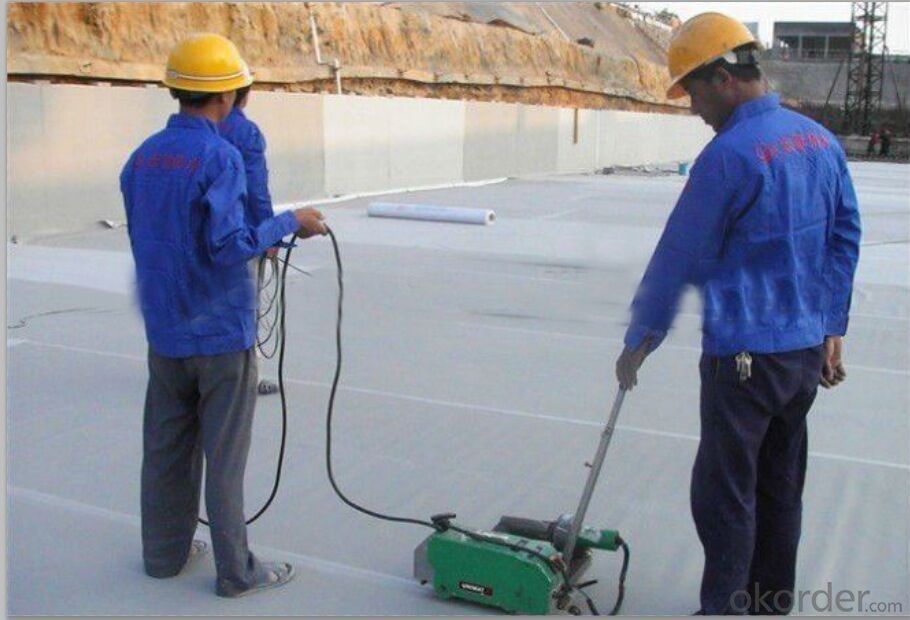


FAQ of PVC Waterproofing Membrane with UV-Resistance:
1. Can you produce 4m width?
Yes, no problem for us. We have four bases in China, largest one in this field.
2. How many quantity in one 20'' container for 1.2mm and 1.5mm?
480rolls, 11520m2 for 1.2mm and 400rolls, 9600m2 for 1.5mm
3. Can you provide free samples?
Yes, our samples are free, but express fees usually on buyer's account.
- Q: Can a waterproofing membrane be used in bridge decks or roadways?
- Yes, a waterproofing membrane can be used in bridge decks or roadways. A waterproofing membrane is a protective layer that is applied to the surface of a structure to prevent water infiltration, thereby increasing the lifespan of the structure. In the case of bridge decks and roadways, which are constantly exposed to harsh weather conditions and heavy traffic, the use of a waterproofing membrane is crucial. Bridge decks and roadways are vulnerable to damage caused by water penetration, such as corrosion of steel reinforcements and the deterioration of concrete. By applying a waterproofing membrane, a barrier is created that prevents water from seeping into the structural elements, reducing the risk of corrosion and extending the durability of the bridge or roadway. Furthermore, a waterproofing membrane can also help to prevent the formation of cracks and potholes, which are often caused by the freeze-thaw cycle and the penetration of water. By keeping the surface of the bridge deck or roadway dry, the membrane helps to maintain its structural integrity and prevent the need for costly repairs or premature replacement. It is worth noting that when considering the use of a waterproofing membrane in bridge decks or roadways, factors such as material selection, installation techniques, and maintenance should be carefully considered. The chosen membrane should be compatible with the materials used in the construction of the bridge or roadway, and the installation process must be carried out properly to ensure a watertight seal. Regular maintenance and inspections should also be conducted to identify any potential issues or damage to the membrane, allowing for timely repairs and ensuring its effectiveness over time. Overall, the use of a waterproofing membrane in bridge decks or roadways is an effective solution to protect against water damage and extend the lifespan of these critical infrastructure elements.
- Q: Are waterproofing membranes resistant to fire?
- Yes, waterproofing membranes can be resistant to fire. Many waterproofing membranes are designed to have fire-resistant properties to ensure the safety of the structure. These membranes are typically made of materials that have high fire ratings and are able to resist the spread of flames. Fire-resistant waterproofing membranes are commonly used in areas where fire safety is a concern, such as commercial buildings, high-rise structures, and industrial facilities. Additionally, these membranes are often tested and certified by relevant authorities to ensure their fire resistance capabilities. However, it is important to note that not all waterproofing membranes are fire-resistant, so it is crucial to select the appropriate membrane based on the specific fire safety requirements of the project.
- Q: Can a waterproofing membrane be used on tunnels with communication systems?
- Yes, a waterproofing membrane can be used on tunnels with communication systems. The membrane can help protect the communication systems from water damage and ensure their proper functioning.
- Q: Can a waterproofing membrane be used on plywood surfaces?
- Yes, a waterproofing membrane can be used on plywood surfaces. Plywood is a commonly used material for construction, including outdoor projects such as decks and balconies. However, plywood is not naturally waterproof and can be susceptible to moisture damage over time. To protect plywood surfaces from water damage, a waterproofing membrane can be applied. This membrane acts as a barrier, preventing water from seeping into the plywood and causing rot or decay. There are various types of waterproofing membranes available, including liquid-applied membranes, sheet membranes, and peel-and-stick membranes. These membranes are designed to adhere to the surface of the plywood and create a watertight seal. It is important to follow the manufacturer's instructions for proper application and ensure that the plywood surface is clean and dry before applying the membrane. By using a waterproofing membrane, plywood surfaces can be effectively protected from water damage, extending their lifespan and maintaining their structural integrity.
- Q: Can a waterproofing membrane be used in conjunction with landscaping or hardscaping projects?
- Yes, a waterproofing membrane can be used in conjunction with landscaping or hardscaping projects. It can provide an additional layer of protection and help prevent water damage to structures or areas where landscaping or hardscaping is being done.
- Q: Are waterproofing membranes resistant to sulfuric acid exposure?
- Yes, waterproofing membranes are generally resistant to sulfuric acid exposure. These membranes are designed to provide a barrier against water and other chemicals, including sulfuric acid. However, the level of resistance may vary depending on the specific type and quality of the membrane. It is advisable to consult with manufacturers or experts to ensure the membrane's compatibility with sulfuric acid exposure in specific applications.
- Q: Are there any specific considerations for installing a waterproofing membrane on stucco surfaces?
- Yes, there are specific considerations for installing a waterproofing membrane on stucco surfaces. Firstly, the stucco surface needs to be clean, dry, and free from any loose debris or contaminants. It is important to ensure that the stucco is properly cured before applying the membrane. Additionally, the choice of waterproofing membrane should be compatible with stucco, considering factors such as flexibility, breathability, and adhesion. Proper application techniques, including thorough coverage and proper overlap of the membrane, are crucial to guarantee its effectiveness. It is also advisable to consult with a professional to ensure the correct installation process and product selection for the specific stucco surface.
- Q: Can a waterproofing membrane be used for warehouses or storage facilities?
- Warehouses or storage facilities can utilize a waterproofing membrane. These membranes are specifically designed to safeguard structures against water damage by creating a barrier that prevents moisture infiltration. In warehouses and storage facilities, there are often large areas that are vulnerable to potential leaks or seepage, such as roofs, walls, and floors. By installing a waterproofing membrane, these structures can be effectively shielded from water intrusion, thereby preventing harm to stored goods and maintaining the facility's integrity. Waterproofing membranes come in various types, including bituminous, liquid-applied, or sheet membranes, providing flexibility in selecting the most appropriate option based on the specific requirements of the warehouse or storage facility. Furthermore, waterproofing membranes offer additional advantages such as thermal insulation and resistance to chemicals, further enhancing their value in ensuring the durability and functionality of warehouses or storage facilities.
- Q: Can waterproofing membranes be used on balconies?
- Yes, waterproofing membranes can be used on balconies. These membranes are designed to provide a protective barrier against moisture, preventing water leaks and damage to the balcony structure. Waterproofing membranes are commonly used in balcony construction and renovation projects to ensure long-lasting water resistance and durability.
- Q: Can a waterproofing membrane be used on precast galvanized surfaces?
- Yes, a waterproofing membrane can be used on precast galvanized surfaces. The waterproofing membrane is designed to provide a protective barrier against water penetration, and it can be applied to various surfaces including precast galvanized surfaces. The membrane helps to prevent water from seeping into the surface, protecting the underlying structure from moisture damage. However, it is important to ensure that the precast galvanized surface is properly prepared before applying the membrane, as any loose or flaking galvanized coating should be removed to ensure proper adhesion of the membrane. Additionally, it is advisable to consult with the manufacturer or supplier of the waterproofing membrane to ensure that it is compatible with galvanized surfaces and to follow their recommended application guidelines for best results.
Send your message to us
PVC Waterproofing Membrane with UV-Resistance
- Loading Port:
- Shanghai
- Payment Terms:
- TT OR LC
- Min Order Qty:
- 20000 m²
- Supply Capability:
- 5000000 m²/month
OKorder Service Pledge
OKorder Financial Service
Similar products
Hot products
Hot Searches
Related keywords
